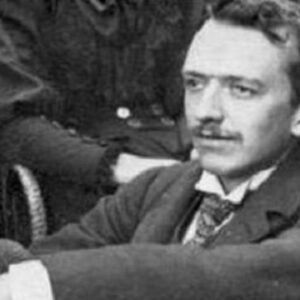Charles Thomson Rees Wilson was a meteorologist and physicist from Scotland. He was fascinated by natural science as a child and studied to become a doctor. He then developed an interest in physics and chemistry and completed his education. He had the opportunity to do research, teach, and work as a reader and demonstrator at Cambridge University throughout his career. His most important contributions include his observations on cloud formation and subsequent construction of the cloud chamber, as well as study on ion behavior. In 1927, he was awarded the Nobel Prize in Physics for his “technique of making the trajectories of electrically charged particles visible by condensation of vapour.” For his study and contributions to physics, he received a number of prestigious honors and recognitions. He remained involved in research throughout his life, and in his latter years, he worked on documenting the ‘theory of thundercloud electricity.’
Childhood and Adolescence
Charles Thomson Rees Wilson was born in Midlothian, Scotland, on February 14, 1869, to farmers John Wilson and Annie Clerk Harper.
In 1873, his father died, and his family relocated to Manchester. Greenheyes Collegiate School in Manchester was where he finished his primary studies.
Later, he enrolled at Owen’s College and majored in Biology with the intention of pursuing a medical career. He obtained a scholarship to Sidney Sussex College in Cambridge in 1888. He became interested in physics and chemistry while studying here.
Career of Charles Thomson Rees Wilson
For a short time, Charles Thomson Rees Wilson taught at Bradford Grammar School in Yorkshire, but due to his strong interest in science, he quickly moved to Cambridge to work as a demonstrator for medical students.
He was interested in meteorology and began researching clouds and their varied features in 1893. During this time, he worked at a Ben Nevis observatory, where he conducted his observations. In his Cambridge laboratory, he used humid air and airtight containers to try to replicate the formation.
At his chamber, he also studied cloud forms caused by radiation and ions. By the year 1896, it had been established that ions in gases could be detected, photographed, and recorded for future research.
In the same year, he was given the ‘Clerk Maxwell Student’ scholarship, which allowed him to conduct research for the next three years. Between 1896 and 1900, he was primarily interested in the behavior of ions as condensation nuclei.
In 1900, he was hired as a professor, demonstrator, and fellow at Cambridge’s Sidney Sussex College. Until 1918, he was a lecturer at the Cavendish Laboratory, where he taught advanced practical physics. He also conducted atmospheric electricity research in 1901.
Charles Thomson Rees Wilson was able to perfect his cloud chamber, a particle detector for detecting ionizing radiation, by 1912. This invention was significant for scientists in the 1920s and 1930s since it backed and proved numerous theories and notions. Arthur Compton demonstrated the ‘Compton Effect,’ Anderson discovered the positron, Blackett and Occhialini demonstrated ‘pair formation’ and ‘annihilation’ of electrons and positrons, and Cockcroft and Walton demonstrated the transmutation of atomic nuclei.
In 1913, he was named an observer in the Department of Meteorological Physics at the Institute of Solar Physics. He was able to investigate the trails of ionizing particles and do studies on thunderstorm electrical while working here. He was promoted to Reader in Electrical Meteorology in 1918.
He became the Jacksonian Professor of Natural Philosophy a few years later, in 1925, and remained there until 1934. Using his knowledge of thunderstorms, he devised a means of protecting British military barrage balloons from lightning while working here. He published his thunderstorm electrical hypothesis in 1956.
He moved to Edinburgh after retiring, and then to the village of Carlops in Glencorse. He worked on his manuscript on the ‘theory of thundercloud electricity’ at this time.
Major Projects of Charles Thomson Rees Wilson
Charles Thomson Rees Wilson was a renowned physicist who is best known for his cloud study and invention, the ‘cloud chamber.’
Achievements & Awards of Charles Thomson Rees Wilson
He was elected a Fellow of the Royal Society in 1900.
In 1922, the Royal Society awarded him the Royal Medal.
In 1925, he was awarded the Howard N. Potts Medal by the Franklin Institute of Philadelphia.
In 1927, Charles Thomson Rees Wilson was awarded the Nobel Prize in Physics.
The Franklin Institute of Philadelphia presented him with the Franklin Medal in 1929.
In 1931, the Institute of Physics awarded him the Duddell Medal and Prize.
Personal History and Legacy
Charles Thomson Rees Wilson married Jessie Fraser in Glasgow in 1908, the daughter of Minister Rev. G. H. Dick. Two sons and two daughters were born to the marriage.
He died in Edinburgh, Scotland, on November 15, 1959. At the time of his death, he was 90 years old.
Estimated Net Worth
The estimated net worth of Charles Thomson Rees Wilson is unknown.


